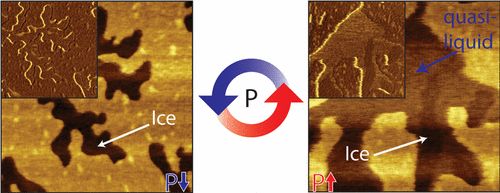Our official English website, www.x-mol.net, welcomes your
feedback! (Note: you will need to create a separate account there.)
Pressure-Induced Melting of Confined Ice
ACS Nano ( IF 15.8 ) Pub Date : 2017-11-10 00:00:00 , DOI: 10.1021/acsnano.7b07472 Kai Sotthewes , Pantelis Bampoulis , Harold J. W. Zandvliet , Detlef Lohse 1 , Bene Poelsema
ACS Nano ( IF 15.8 ) Pub Date : 2017-11-10 00:00:00 , DOI: 10.1021/acsnano.7b07472 Kai Sotthewes , Pantelis Bampoulis , Harold J. W. Zandvliet , Detlef Lohse 1 , Bene Poelsema
Affiliation

|
The classic regelation experiment of Thomson in the 1850s deals with cutting an ice cube, followed by refreezing. The cutting was attributed to pressure-induced melting but has been challenged continuously, and only lately consensus emerged by understanding that compression shortens the O:H nonbond and lengthens the H–O bond simultaneously. This H–O elongation leads to energy loss and lowers the melting point. The hot debate survived well over 150 years, mainly due to a poorly defined heat exchange with the environment in the experiment. In our current experiment, we achieved thermal isolation from the environment and studied the fully reversible ice–liquid water transition for water confined between graphene and muscovite mica. We observe a transition from two-dimensional (2D) ice into a quasi-liquid phase by applying a pressure exerted by an atomic force microscopy tip. At room temperature, the critical pressure amounts to about 6 GPa. The transition is completely reversible: refreezing occurs when the applied pressure is lifted. The critical pressure to melt the 2D ice decreases with temperature, and we measured the phase coexistence line between 293 and 333 K. From a Clausius–Clapeyron analysis, we determine the latent heat of fusion of two-dimensional ice at 0.15 eV/molecule, being twice as large as that of bulk ice.
中文翻译:

压力致密冰融化
汤姆森(Thomson)在1850年代进行的经典胶凝实验是切冰块,然后重新冷冻。切削是由于压力引起的熔化而引起的,但一直受到挑战,只有最近才达成共识,即压缩会缩短O:H非键并同时延长H-O键。H–O伸长会导致能量损失并降低熔点。这场激烈的辩论幸存了150多年,主要是由于实验中与环境的热交换定义不明确。在我们目前的实验中,我们实现了与环境的隔热,并研究了石墨烯和白云母云母之间水的完全可逆的冰-液水过渡。通过施加由原子力显微镜尖端施加的压力,我们观察到了从二维(2D)冰到准液相的过渡。在室温下,临界压力约为6 GPa。过渡过程是完全可逆的:解除施加的压力会发生重新冻结。熔化2D冰的临界压力随温度降低,我们测量了293和333 K之间的相存共存线。根据Clausius-Clapeyron分析,我们确定了二维冰融化的潜热为0.15 eV /分子,是大块冰的两倍。
更新日期:2017-11-11
中文翻译:

压力致密冰融化
汤姆森(Thomson)在1850年代进行的经典胶凝实验是切冰块,然后重新冷冻。切削是由于压力引起的熔化而引起的,但一直受到挑战,只有最近才达成共识,即压缩会缩短O:H非键并同时延长H-O键。H–O伸长会导致能量损失并降低熔点。这场激烈的辩论幸存了150多年,主要是由于实验中与环境的热交换定义不明确。在我们目前的实验中,我们实现了与环境的隔热,并研究了石墨烯和白云母云母之间水的完全可逆的冰-液水过渡。通过施加由原子力显微镜尖端施加的压力,我们观察到了从二维(2D)冰到准液相的过渡。在室温下,临界压力约为6 GPa。过渡过程是完全可逆的:解除施加的压力会发生重新冻结。熔化2D冰的临界压力随温度降低,我们测量了293和333 K之间的相存共存线。根据Clausius-Clapeyron分析,我们确定了二维冰融化的潜热为0.15 eV /分子,是大块冰的两倍。











































 京公网安备 11010802027423号
京公网安备 11010802027423号